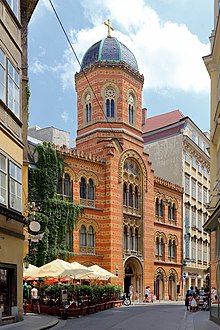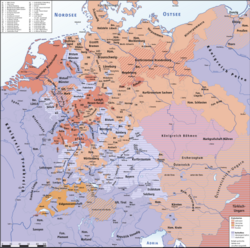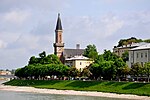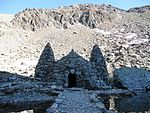Religion in Austria (2021)
Roman Catholicism (55.2%) Eastern Orthodoxy (4.9%) Protestantism (3.8%) Old Catholicism (0.1%) Other Christians (4.2%) Islam (8.3%) Buddhism (0.3%) Hinduism (0.1%) Judaism (0.1%) Other religions (0.7%) No religion (22.4%)

Religion in Austria is predominantly Christianity, adhered to by 68.2% of the country's population according to the 2021 national survey conducted by Statistics Austria. Among Christians, 80.9% were Catholics, 7.2% were Orthodox Christians (mostly belonging to the Eastern Orthodox Church), 5.6% were Protestants, while the remaining 6.2% were other Christians, belonging to other denominations of the religion or not affiliated to any denomination. In the same census, 8.3% of the Austrians declared that their religion was Islam, 1.2% declared to believe in other non-Christian religions (including Buddhism, Hindusim, Judaism and others), and 22.4% declared they did not belong to any religion, denomination or religious community.
According to church membership data, in 2023 50.6% of the population were Roman Catholics and 2.7% adhered to Protestant churches.
Austria was historically a strongly Catholic country, having been the centre of the Habsburg monarchy (1273–1918) which championed Roman Catholicism. Although in the 16th century many Austrians converted to Protestantism, Lutheranism in particular, as the Protestant Reformation (begun in 1517) was spreading across Europe, the Habsburgs enacted measures of Counter-Reformation as early as 1527 and harshly repressed Austrian Protestantism, albeit a minority of Austrians remained Protestant. A few decades after the fall of the Habsburg monarchy at the end of the World War I, and the transformation of Austria into a federal republic, at least since the 1970s there has been a decline of Christianity (with the exception of Orthodox churches) and a proliferation of other religions, a process which has been particularly pronounced in the capital state of Vienna.
Between the censuses of 1971 and 2021, Christianity declined from 93.8% to 68.2% of the Austrian population (Catholicism from 87.4% to 55.2%, and Protestantism from 6% to 3.8%, while Orthodox Christianity grew from 2.2% to 4.9% between 2001 and 2021). During the same timespan, Islam grew from being the religion of 0.2% to 8.3% of the Austrian population, and the proportion of people neither affiliating with nor belonging to any religion grew from 4.3% to 22.4%.
Demographics
Census statistics, 1951–2021
| Religion | 1951 | 1961 | 1971 | 1981 | 1991 | 2001 | 2021 | |||||||
|---|---|---|---|---|---|---|---|---|---|---|---|---|---|---|
| Number | % | Number | % | Number | % | Number | % | Number | % | Number | % | Number | % | |
| Christianity | 6,632,500 | 95.7 | 6,763,400 | 95.6 | 7,022,400 | 93.8 | 6,821,300 | 90.2 | 6,489,100 | 83.2 | 6,485,700 | 80.7 | 6,093,700 | 68.2 |
| —Catholicism | 6,170,100 | 89.0 | 6,295,100 | 89.0 | 6,548,300 | 87.4 | 6,372,600 | 84.3 | 6,081,500 | 78.0 | 5,915,400 | 73.6 | 4,933,300 | 55.2 |
| —Orthodox Christianity** | – | – | – | – | – | – | – | – | – | – | 179,500 | 2.2 | 436,700 | 4.9 |
| —Protestantism | 429,500 | 6.2 | 438,700 | 6.2 | 447,100 | 6.0 | 423,200 | 5.6 | 388,700 | 5.0 | 376,200 | 4.7 | 340,300 | 3.8 |
| —Old Catholicism | 32,900 | 0.5 | 29,600 | 0.4 | 27,000 | 0.4 | 25,500 | 0.3 | 18,900 | 0.2 | 14,600 | 0.2 | 4,900 | 0.1 |
| —Other Christians*** | – | – | – | – | – | – | – | – | – | – | – | – | 378,500 | 4.2 |
| Islam** | – | – | – | – | 22,300 | 0.3 | 76,900 | 1.0 | 158,800 | 2.0 | 339,000 | 4.2 | 745,600 | 8.3 |
| Buddhism**** | – | – | – | – | – | – | – | – | – | – | 10,400 | 0.1 | 26,600 | 0.3 |
| Hinduism**** | – | – | – | – | – | – | – | – | – | – | 3,600 | 0.0 | 10,100 | 0.1 |
| Judaism | 11,200 | 0.2 | 9,000 | 0.1 | 8,500 | 0.1 | 7,100 | 0.1 | 7,300 | 0.1 | 8,100 | 0.1 | 5,400 | 0.1 |
| Other religions | 23,100 | 0.3 | 31,400 | 0.4 | 74,400 | 1.0 | 118,900 | 1.6 | 197,400 | 2.5 | 62,200 | 0.9 | 62,100 | 0.7 |
| No religion | 264,000 | 3.8 | 266,000 | 3.8 | 321,200 | 4.3 | 452,000 | 6.0 | 672,300 | 8.6 | 963,300 | 12.0 | 1,997,700 | 22.4 |
| Not stated | 3,100 | 0.0 | 4,000 | 0.1 | 42,800 | 0.6 | 79,000 | 1.0 | 271,000 | 3.5 | 160,700 | 2.0 | – | – |
| Total population | 6,933,900 | 7,073,800 | 7,491,500 | 7,555,300 | 7,795,800 | 8,032,900 | 8,935,800 | |||||||
| *1951–2001: religious affiliations of the entire population counted in the census. 2021-: religious affiliations counted in a microcensus and extrapolated to the total population. **Orthodox Christianity and Islam were counted as part of "other religions" until, respectively, the censuses of 1971 and 2001, in which they began to be counted separately. ***In 2021, 378,500 people were counted in the "Christianity" category in one census table but in the "other religions" category in another table, making the distinction blurry. ****Buddhism and Hinduism were counted separately, albeit only in some data reports, at least since the census of 2001. | ||||||||||||||
Religion by federal state
| Federal state | Christianity total | Catholicism | Orthodox Christianity | Protestantism | Islam | Other religions | No religion | ||||||||
|---|---|---|---|---|---|---|---|---|---|---|---|---|---|---|---|
| Number | % | Number | % | Number | % | Number | % | Number | % | Number | % | Number | % | ||
| 237,900 | 80.3 | 194,100 | 65.5 | 8,000 | 2.7 | 33,700 | 11.4 | 6,400 | 2.2 | 2,100 | 0.7 | 49,900 | 16.8 | ||
| 434,500 | 77.2 | 356,900 | 63.4 | 20,700 | 3.7 | 41,800 | 7.4 | 31,100 | 5.5 | 3,900 | 0.7 | 93,100 | 16.5 | ||
| 1.242,000 | 73.4 | 983,100 | 58.1 | 49,000 | 2.9 | 56,700 | 3.3 | 83,200 | 4.9 | 21,500 | 1.3 | 346,500 | 20.5 | ||
| 1.098,600 | 73.4 | 931,300 | 62.3 | 43,000 | 2.9 | 48,500 | 3.2 | 125,500 | 8.4 | 12,800 | 0.9 | 259,200 | 17.3 | ||
| 415,500 | 74.2 | 322,000 | 57.5 | 28,100 | 5.0 | 17,100 | 3.0 | 36,400 | 6.5 | 6,600 | 1.2 | 101,900 | 18.2 | ||
| 894,300 | 71.7 | 789,300 | 63.3 | 34,100 | 2.7 | 39,600 | 3.2 | 63,400 | 5.1 | 8,400 | 0.7 | 281,500 | 22.6 | ||
| 556,300 | 73.2 | 502,600 | 66.2 | 23,400 | 3.1 | 22,700 | 3.0 | 65,900 | 8.7 | 2,500 | 0.3 | 134,800 | 17.8 | ||
| 942,000 | 49.0 | 611,700 | 31.8 | 215,200 | 11.2 | 70,300 | 3.7 | 284,900 | 14.8 | 38,700 | 2.0 | 655,400 | 34.1 | ||
| 272,700 | 68.3 | 242,400 | 60.7 | 15,100 | 3.8 | 10,000 | 2.5 | 48,800 | 12.2 | 2,500 | 0.6 | 75,400 | 18.9 | ||
| N.b. Percentages do not add up to 100%; the remainder, which is not reported in this table, was counted as part of "Christianity" by the 2021 census compilers. | |||||||||||||||
History

The Protestant Reformation spread from northern Germany to Austria. By the Council of Trent in 1545, almost half of the Austrian population had converted to Lutheranism, while a minority also endorsed Calvinism. Eastern Austria was more affected by this phenomenon than western Austria. After 1545, Austria was recatholicized in the Counter Reformation. The Habsburgs imposed a strict regime to restore the influence of the Catholic Church among Austrians and their campaign proved successful. The Habsburgs for a long time viewed themselves as the vanguard of Catholicism, while all the other Christian confessions and religions were repressed.
In 1775, Maria Theresa gave official permission to the Mechitarist Congregation of the Armenian Catholic Church to settle in the Habsburg Empire.
In 1781, in the era of Austrian enlightenment, Emperor Joseph II issued a Patent of Tolerance for Austria that allowed other confessions a limited freedom of worship. Religious freedom was declared a constitutional right in Cisleithania after the Austro-Hungarian Ausgleich in 1867, thus paying tribute to the fact that the monarchy was home to numerous religions besides Catholicism such as Greek, Serbian, Romanian, Russian, and Bulgarian Orthodox Christians (Austria neighboured the Ottoman Empire for centuries), both Calvinist and Lutheran Protestants, and Jews. In 1912, after the annexation of Bosnia Hercegovina in 1908, Islam was officially recognised in Austria.
The Austrian Jewish community of 1938—Vienna alone counted more than 200,000—was reduced to around 4,500 during the Second World War, with about 65,000 Jewish Austrians killed in the Holocaust and 130,000 emigrating. The large majority of the current Jewish population are post-war immigrants, particularly from eastern Europe and central Asia (including Bukharan Jews). Buddhism was legally recognised as a religion in Austria in 1983.
Austria was greatly affected by the Protestant Reformation, to a point where a significant part of the population became Protestant. Lutheranism was the most successful Protestant confession; that was the case among other German-speaking populations across the Holy Roman Empire and Austria was indeed one of them. Calvinism did not receive that much support. The prominent position of the Habsburgs in the Counter-Reformation, however, saw Protestantism all but wiped out beginning in 1545, restoring Catholicism as the dominant religion once more.
The significant Jewish population (around 200,000 in 1938), mainly residing in Vienna, was reduced to just a couple of thousand through mass emigration in 1938 (more than 2/3 of the Jewish population emigrated from 1938 until 1941), and the following Holocaust during the Nazi period. Immigration in more recent years, primarily from Turkey and the former Yugoslavia, has led to an increased number of Muslims and Serbian Orthodox Christians. As in other European countries, there has been a growth of Pagan movements in Austria in recent years.
Religions





Christianity
Catholic Church
Main article: Catholic Church in AustriaCatholicism is the largest religion in Austria, representing 57.9% of the total population in 2017. The Catholic Church's governing body in Austria is the Austrian Conference of Catholic Bishops, made up of the hierarchy of the two archbishops (Vienna, Salzburg), the bishops and the abbot of territorial abbey of Wettingen-Mehrerau. Nevertheless, each bishop is independent in his own diocese, answerable only to the Pope. The current president of the Conference of Catholic Bishops is Cardinal Christoph Schönborn, who belongs to the Central European noble family of Schönborn. Although Austria has no primate, the archbishop of Salzburg is titled Primus Germaniae (Primate of Germany).
Orthodox Christianity
Main article: Eastern Orthodoxy in AustriaEastern Orthodox and Oriental Orthodox churches grew over the last decades due to the coming of South Slavic immigrants from the Balkans to Austria. The largest group of Eastern Orthodox in Austria are Serbs. The Vienna Institute of Demography of the Austrian Academy of Sciences estimated in that there were 397,219 Eastern Orthodox Christians in Austria in 2016, representing the 4.6% of the total population.
Protestantism
The Protestant Reformation spread from northern Germany to Austria. By the Council of Trent in 1545, almost half of the Austrian population had converted to Lutheranism, while a much smaller minority also endorsed Calvinism. Eastern Austria was more affected by this phenomenon than western Austria. After 1545, Austria was recatholicized in the Counter Reformation. The Habsburgs imposed a strict regime to restore the influence of the Catholic Church among Austrians and their campaign proved successful; the Habsburgs for a long time viewed themselves as the vanguard of Catholicism, while all the other Christian confessions and religions were suppressed.
Protestantism reached a peak percentage of 6.2% by 1951 for the first time in Austrian history since the success of the Counter-Reformation. Currently, it claims around 3.5% of the population. Austrian Protestants are overwhelmingly Lutheran (3.4%), with a small Reformed community (0.1%). New arriving Protestant churches are growing in membership, especially Evangelical Protestants and Pentecostals.
A study from the Vienna Institute of Demography of the Austrian Academy of Sciences found that there were an estimate of 412,423 Protestants of all types in Austria in 2016. The Lutheran Protestant Church of the Augsburg Confession in Austria has about 300,000 (3.4%) members. The Reformed Church in Austria, a Calvinist body, has roughly 13,590 members.
The Mennonite World Conference counted a small Mennonite population in Austria. In 2022, there were 402 Mennonites.
The German Yearly Meeting of Quakers includes Quakers in both Germany and Austria and numbered less than 500 in 2017.
Islam
Main article: Islam in AustriaDue to immigration, especially from the Balkans, Turkey and the Middle East, the number of Muslims in Austria has grown exponentially over the latest decades, with an estimated number of Muslims of 686,599, or 7.9% of the total population as of 2016, up from 4.2% in 2001.
| Year | Absolute number | Percentage | Source |
|---|---|---|---|
| 1981 | 76,939 | 1.0% | |
| 1991 | 158,776 | 2.0% | |
| 2001 | 345,906 | 4.1% | |
| 2009 | 515,914 | 6.2% | |
| 2016 | 686,599 | 7.9% | |
| 2021 | 745,600 | 8.3% |
Buddhism
Main article: Buddhism in AustriaBuddhism is a legally recognized religion in Austria and it is followed by thousands of people. Although still small in absolute numbers (10,402 at the 2001 census), Buddhism enjoys widespread acceptance in Austria. A majority of Buddhists in the country are Austrian nationals (some of them naturalized after immigration from Asia, predominantly from China and Vietnam), while a considerable number of them are foreign nationals.
As in most European countries, different branches and schools of Buddhism are represented by groups of varying sizes. Vienna not only has the largest number of foreign residents, but is also the place with the longest tradition of Buddhism in the country. Most of Austria's Buddhist temples and centres of practice can be found there; some with a specific Chinese, Vietnamese, Tibetan or Japanese appearance. The latest development has been the establishment of a "Buddhist cemetery" around a stupa-like building for funeral ceremonies at the Vienna Central Cemetery.
Hinduism
Main article: Hinduism in AustriaHinduism is a minority religion in Austria, and according to the 2001 census, it was the religion of 3629 people. Since 1998, the 'Hindu Community in Austria' (HRÖ), the official representative of Hindus in Austria, has been able to call itself an 'Official registered confessional community', yet does not enjoy full legal recognition from the state.
Paganism
Austria has seen a growth of Pagan movements in recent years, especially Druidic (Druidentum), but also Germanic Heathen (Heidentum), Wiccan and Neopagan witchcraft (Hexentum) groups. As of 2010 Austrian motorway authorities have been hiring Druids for geomantic works intended to reduce the number of accidents on the worst stretches of Austrian speedways.
Celtic Neopaganism and Neo-Druids are particularly popular in Austria, by virtue of Austria being the location of the proto-Celtic Hallstatt culture. The Keltendorf in Diex, Kärnten combines archaeological reconstruction with "European geomancy". The Europäische Keltische Gemeinschaft has been active since 1998.
Membership of churches
| Main denominations in Austria | |||||||
| Year | Population | Catholics | Percentage | Protestants | Percentage | ||
|---|---|---|---|---|---|---|---|
| 1951 | 6,933,905 | 6,170,084 | 89.0% | 429,493 | 6.2% | ||
| 1961 | 7,073,807 | 6,295,075 | 89.0% | 438,663 | 6.2% | ||
| 1971 | 7,491,526 | 6,548,316 | 87.4% | 447,070 | 6.0% | ||
| 1981 | 7,555,338 | 6,372,645 | 84.3% | 423,162 | 5.6% | ||
| 1991 | 7,795,786 | 6,081,454 | 78.0% | 388,709 | 5.0% | ||
| 2001 | 8,032,926 | 5,915,421 | 73.6% | 376,150 | 4.7% | ||
| 2011 | 8,408,121 | 5,403,722 | 64.3% | 319,752 | 3.8% | ||
| 2012 | 8,451,860 | 5,359,151 | 63.4% | 325,905 | 3.9% | ||
| 2013 | 8,507,786 | 5,308,515 | 62.4% | 313,352 | 3.7% | ||
| 2014 | 8,584,926 | 5,265,378 | 61.4% | 309,158 | 3.6% | ||
| 2015 | 8,700,471 | 5,211,238 | 59.9% | 306,183 | 3.5% | ||
| 2016 | 8,773,686 | 5,162,622 | 58.8% | 301,729 | 3.4% | ||
| 2017 | 8,823,054 | 5,112,330 | 57.9% | 296,338 | 3.4% | ||
| 2018 | 8,859,992 | 5,053,074 | 57.0% | 292,597 | 3.3% | ||
| 2019 | 4,980,000 | ||||||
| 2022 | 8,978,929 | 4,830,000 | 53.7% | ||||
See also
- Buddhism in Austria
- Catholic Church in Austria
- Old Catholic Church of Austria
- Hinduism in Austria
- Islam in Austria
- History of the Jews in Austria
- Religions by country
- Freedom of religion in Austria
Notes
- ^ Since 2011, Statistics Austria switched the census methodology from the traditional face-to-face and module-based census to a register-based census; the latter does not allow populations to be directly queried about certain topics, such as religious affiliation. As a consequence, the 2011 census did not provide information about the religious affiliations of Austrians. In 2021, Statistics Austria adopted a combined census methodology, and the question about religion was introduced again through a microcensus, or national survey, complementing the register-based census.
References
Citations
- ^ Official census data provided by Statistics Austria:
- "Bevölkerung 2001 nach Religionsbekenntnis und Staatsangehörigkeit" [2001 population by religious confession and nationality]. Archived from the original on 13 November 2010. Retrieved 19 August 2022.
- "Bevölkerung nach dem Religionsbekenntnis und Bundesländern 1951 bis 2001" [Population by religious confession and federal states from 1951 to 2001] (PDF). Archived from the original (PDF) on 16 May 2022.
- "Religionsbekenntnis, 1951–2021" [Religious confession, 1951–2021]. Archived from the original on 17 August 2022.
- "Religionszugehörigkeit 2021: drei Viertel bekennen sich zu einer Religion" [2021 religious affiliation: three fourths profess a religion] (PDF) (with comparative data from the censuses from 1951 to 2021). Archived (PDF) from the original on 4 August 2022.
- Austrian church statistics, katholisch.at
- Evangelische Kirche in Österreich: Data and facts
- ^ Zulehner 2004, p. 1.
- Potančoková & Berghammer 2012, pp. 219, 230.
- "Imperial Gazette −1912". IGGIO Islamische Glaubensgemeinschaft in Osterreich. 2011. Retrieved 4 June 2014.
- Expulsion, Deportation and Murder – History of the Jews in Vienna Vienna Webservice
- Bukharian Jews find homes on Long Island, Bukharian Reviews, 16 September 2004
- "Religionsbekenntnis". AEIOU. Retrieved 22 May 2009.
- "Religion in Austria on Sacred Destinations". Archived from the original on 2006-05-23. Retrieved April 21, 2007.
- ^ Austrian Catholic Church data 2017
- ^ Goujon, Anne; Jurasszovich, Sandra; Potančoková, Michaela (August 2017). "Religious denominations in Austria" (PDF). Vienna Institute of Demography of the Austrian Academy of Sciences: 102.
- ^ "Zahlen und Fakten" [Numbers and Facts]. Evangelical Church in Austria. 31 December 2010. Retrieved 19 January 2016.
- "Mennonite World Conference World Map 2022" (PDF). MWC-CMM. Retrieved August 1, 2024.
- "FWCC World Map 2017" (PDF). FWCC. March 2017. Retrieved August 1, 2024.
- ^ Mathias Vogl; Alexander Janda, eds. (2010). "Islam in Österreich" [Islam in Austria] (PDF). Österreichischer Integrationsfonds (in German). Archived from the original (PDF) on 4 March 2014.
- WZ-Recherche 2016. Published in article: "Staat und Religion". Wiener Zeitung, January 2016.
- ^ Elsaidy, Amro (2014). Muslimische Jugendliche in Österreich am Beispiel Graz: Ein Leben zwischen Moschee und Diskothek (PDF) (Thesis). Universität Wien. p. 39. S2CID 194611223. Archived from the original (PDF) on 2020-02-18.
- "HRÖ - Our History". Hroe.at. Archived from the original on 29 January 2016. Retrieved 19 January 2016.
- Druids cut death toll with divine intervention. The Telegraph.
- Motorway druids tackle road accidents. Austrian Times.
- "Bevölkerung nach dem Religionsbekenntnis und Bundesländern 1951 bis 2001" [Population by religious denomination and Federal State from 1951 to 2001] (PDF) (in German). Statistical Office of Austria. 1 June 2007. Retrieved 19 January 2016.
- "Katholische Kirche Österreich: Statistik" [Catholic Church Austria: Statistics] (in German). Katholisch.at. Archived from the original on 2013-03-14. Retrieved 12 February 2017.
- "Statistical Data 2001–2016" (in German). Evang.at. 12 February 2016. Retrieved 12 February 2016.
- Only Evangelical Lutherans & Evangelical Reformed
- "Kirchenaustritte in Österreich um 14,9 Prozent gestiegen". 15 January 2020.
- "Kirchenaustritte stiegen nach CoV-Beruhigung wieder". 12 January 2022.
Sources
- Potančoková, Michaela; Berghammer, Caroline (2012). "Urban Faith: Religious Change in Vienna and Austria, 1986–2013" (PDF). In Hödl, Hans Gerald; Pokorny, Lukas (eds.). Religion in Austria. Vol. 2. Praesens Verlag. pp. 217–251. ISBN 9783706907637. Archived from the original (PDF) on 7 January 2022.
- Zulehner, Paul M. (2004). "Religion in Austria" (PDF). In Bischof, Günter; Pelinka, Anton; Denz, Hermann (eds.). Religion in Austria. Contemporary Austrian Studies. Vol. 13. Taylor & Francis. pp. 37–62 (1–21). ISBN 9780765808233.
Further reading
- Hödl, Hans Gerald; Pokorny, Lukas, eds. (2012–2021). Religion in Austria. Vol. 1–6. Praesens Verlag.
- Kosinsky, Danuta; Stiegnitz, Peter, eds. (1990). Religions in Austria. Federal Press Service.
| Religion in Austria | ||
|---|---|---|
| Christianity in Austria |  | |
| Other religions | ||
| Related | ||
| Austria articles | |||||
|---|---|---|---|---|---|
| History |
| ||||
| Geography | |||||
| Politics | |||||
| Economy | |||||
| Society |
| ||||
| Religion in Europe | |
|---|---|
| Sovereign states |
|
| States with limited recognition | |
| Dependencies and other entities | |
| Other entities | |